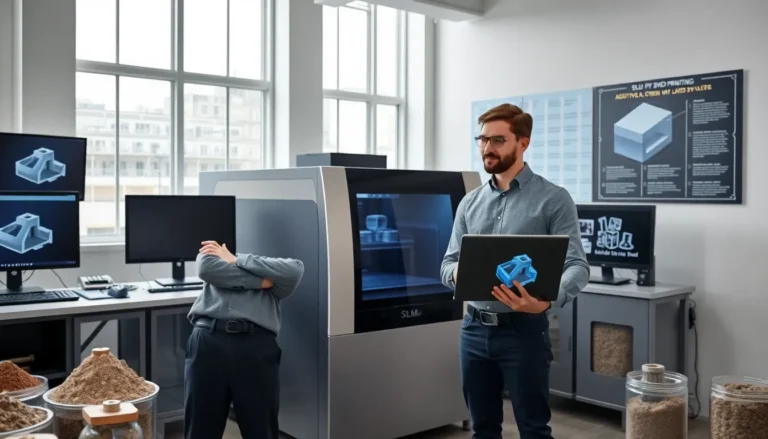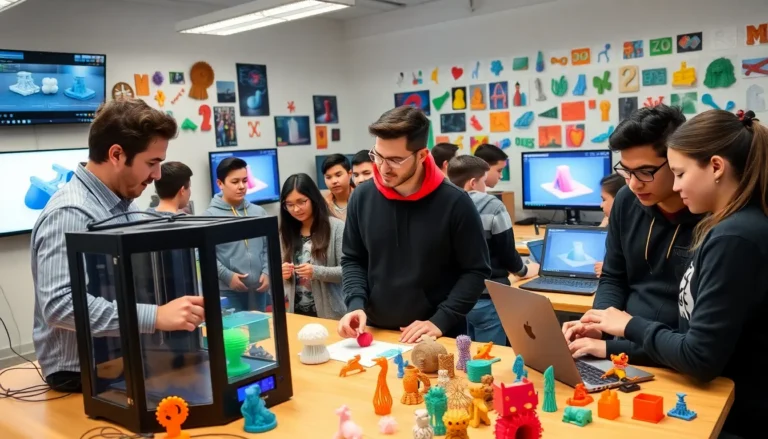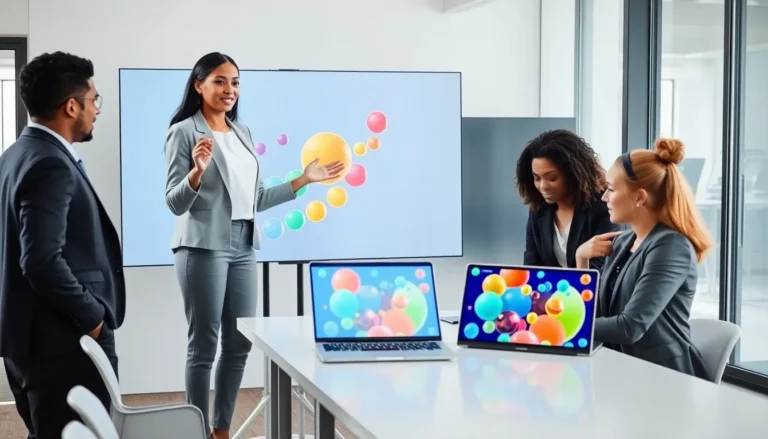Table of Contents
ToggleIn the rapidly evolving world of technology, 3D printing stands out as a game-changer. This innovative process allows individuals and businesses to create complex designs with ease, transforming ideas into tangible objects. With its growing popularity, access to reliable 3D print resources has never been more essential for enthusiasts and professionals alike.
From beginner-friendly tutorials to advanced modeling software, the right resources can significantly enhance one’s 3D printing experience. Whether someone is looking to refine their skills or explore new creative avenues, a wealth of information is available. This article will delve into the top resources that can elevate any 3D printing project, making the journey from concept to creation smoother and more enjoyable.
Overview of 3D Print Resources
3D print resources encompass various tools, materials, and support systems essential for successful 3D printing projects. These resources serve both beginners and experienced users, enhancing their ability to create high-quality prints efficiently.
Types of 3D Print Resources
- Software Tools: Software tools aid in designing and preparing 3D models for printing. Popular programs include Blender, Tinkercad, and Fusion 360. Each provides unique features, catering to different skill levels and project requirements.
- Printing Materials: Printing materials play a crucial role in achieving desired print characteristics. Common materials include PLA, ABS, PETG, and TPU. Each material varies in strength, flexibility, and ease of use.
- 3D Printers: 3D printers vary significantly in design and capability. FDM, SLA, and SLS are prominent technologies. Each printer type has specific applications and benefits, making the choice dependent on project needs.
- Online Communities: Online communities offer vital support and knowledge sharing among users. Platforms like Reddit, Thingiverse, and various Facebook groups connect users with experienced individuals who provide advice and share resources.
- Educational Resources: Educational resources facilitate skill development. Websites like Coursera and Udemy offer courses on 3D modeling and printing techniques, catering to different proficiency levels.
- Prototyping Services: Prototyping services help users who lack access to 3D printers. Companies like Shapeways and Sculpteo provide printing services, allowing users to upload designs and receive physical products.
Importance of Utilizing 3D Print Resources
Utilizing 3D print resources enhances project quality and efficiency. Access to diverse software, materials, and support networks enables users to overcome challenges and refine their skills. This approach promotes innovation and creativity in 3D printing endeavors.
Types of 3D Print Resources

Accessing various resources enhances the 3D printing experience, significantly affecting the outcome of projects. Key resources include materials and software, which play a crucial role in the printing process.
Materials for 3D Printing
Choosing the right materials impacts print quality and functionality. Common materials include:
- PLA (Polylactic Acid): Biodegradable, easy to print, and suitable for beginners. It offers good layer adhesion and a smooth finish.
- ABS (Acrylonitrile Butadiene Styrene): Durable and heat-resistant, ideal for functional parts. Often used in automotive and consumer goods.
- PETG (Polyethylene Terephthalate Glycol-Modified): Strong and flexible, offering good chemical resistance and ease of printing. Popular for producing objects that require durability.
- Nylon: Known for its strength and flexibility, suitable for mechanical parts and gears.
- TPU (Thermoplastic Polyurethane): A flexible material designed for creating soft, rubber-like prints. Best for items like phone cases and wearables.
Selecting appropriate materials based on project requirements ensures optimal results during printing.
Software for 3D Printing
Software tools facilitate the design and printing process, crucial for creating accurate models. Notable software options include:
- Blender: An open-source 3D modeling tool with extensive features for professional-grade designs.
- Tinkercad: A user-friendly online platform suitable for beginners, allowing quick model creation with a simple interface.
- Fusion 360: A professional CAD software offering a robust set of tools for advanced modeling and simulation.
- Cura: A slicing software that converts 3D models into instructions for 3D printers, optimizing print settings for quality.
- Meshmixer: A tool designed for editing and optimizing mesh models, focusing on making seamless prints.
Utilizing the right software streamlines the design and preparation phases, leading to more successful prints and efficient workflows.
Where to Find 3D Print Resources
Accessing reliable 3D print resources is essential for all individuals involved in 3D printing. Numerous platforms and communities offer invaluable support and knowledge sharing for both beginners and experienced users.
Online Platforms
Several online platforms provide diverse resources for 3D printing.
- Thingiverse: A popular repository for sharing 3D printable files, it offers a vast collection of user-generated designs.
- MyMiniFactory: It hosts a curated selection of 3D models, ensuring designs are printable and often supports user projects.
- Cults3D: This platform includes a mix of free and paid models, catering to various interests and project needs.
- YouMagine: It features a community-driven collection of designs, allowing users to contribute and share their creations.
These online platforms facilitate easy access to 3D models and enhance the collaborative aspects of 3D printing.
Community and Forums
Engaging with online communities and forums greatly benefits 3D printing enthusiasts.
- Reddit: Subreddits like r/3Dprinting serve as hubs for discussion, troubleshooting, and sharing experiences related to 3D printing.
- 3D Printing Stack Exchange: This Q&A site focuses on technical questions, providing expert answers and insights for various 3D printing challenges.
- Facebook Groups: Numerous groups support niche interests within 3D printing, fostering connections and the exchange of information.
- Local Maker Spaces: Many cities feature maker spaces, where individuals can collaborate and share resources in person, making connections with local enthusiasts.
Participating in these communities fosters learning and collaboration, enhancing the overall 3D printing experience.
Best Practices for Using 3D Print Resources
Utilizing 3D print resources effectively requires specific strategies. Implement these best practices to optimize the experience and outcomes.
Choose the Right Materials
Selecting appropriate materials enhances the strength and finish of final prints. Consider common options like:
- PLA: Ideal for beginners due to its ease of use and biodegradable properties.
- ABS: Offers durability and heat resistance, suitable for functional parts.
- PETG: Combines the benefits of PLA and ABS, known for its strength and flexibility.
- Nylon: Ideal for flexible and durable prints, often used in mechanical applications.
- TPU: Great for producing flexible parts like phone cases.
Utilize Efficient Software Tools
Using specialized software enhances design accuracy and printing efficiency. Notable software options include:
- Blender: Versatile for complex modeling, animations, and rendering.
- Tinkercad: User-friendly for beginners, allowing quick 3D design creation.
- Fusion 360: Powerful CAD tool for engineering and product design.
- Cura: Effective slicing software for preparing models for printing.
- Meshmixer: Useful for repairing and modifying STL files.
Engage with Online Communities
Participating in online communities offers invaluable support and guidance. Join platforms like:
- Reddit: Various subreddits provide advice and troubleshooting tips.
- 3D Printing Stack Exchange: Ideal for asking specific technical questions.
- Facebook Groups: Connect with enthusiasts and industry experts for tips.
- Local Maker Spaces: Collaborate and learn from other 3D printing enthusiasts.
Keep Learning Through Educational Resources
Continuously expanding knowledge accelerates skill development. Enroll in courses from:
- Coursera: Offers comprehensive classes on 3D design and printing.
- Udemy: Features various tutorials catering to different skill levels.
Test and Iterate Designs
Prototyping allows for testing designs before final prints. Utilize services like:
- Shapeways: Prints custom designs in various materials, offering high-quality results.
- Sculpteo: Provides on-demand printing and various material options.
Document and Share Experiences
Sharing experiences contributes to the community and aids personal improvement. Document projects by:
- Creating a Blog: Outline steps, challenges, and outcomes of projects.
- Posting on Social Media: Showcase finished prints and gather feedback.
Implementing these best practices enhances the efficiency and creativity in 3D printing projects.
Harnessing the right 3D print resources can significantly elevate the quality and efficiency of any project. By utilizing suitable software tools and materials, individuals can streamline their design and printing processes. Engaging with online communities not only provides essential support but also fosters collaboration and innovation.
Continuous learning through educational platforms ensures that both beginners and seasoned professionals stay updated with the latest techniques and trends. Embracing prototyping services allows users to test their designs effectively. Overall, leveraging these resources cultivates a more enriching and productive 3D printing experience, paving the way for endless creative possibilities.







